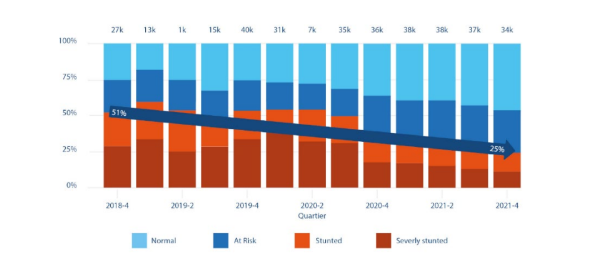
Integrating for impact on stunting
by Max Foundation
Despite positive trends world-wide, undernutrition remains a major global public health challenge, particularly amongst children under the age of five. In 2020, an estimated 149 million or 22% of children under the age of five were stunted.
Stunting explained
Stunting is when a child is too short for his or her age. It is a key indicator for child health, and is caused by undernutrition – not just because of poor diet, but also because of infections from unsafe water and exposure to faecal matter. Stunting can cause long-term mental and physical disabilities, and on average stunted children earn 15.8% less in their lifetime than their peers. In South Asia and sub-Saharan Africa, around one in three children is stunted. It’s estimated that about half of them become stunted during pregnancy and in the first six months of life, when a child is fully dependent on the mother for nutrition.
Max Foundation’s approach
Max Foundation’s evidence-based Healthy Village approach mobilizes the whole community around child health, working to stimulate both demand and supply of healthy products and services. It tackles stunting by combining key elements:
• Intake of nutritious, diverse, and safe foods in early childhood.
• Access to safe water, sanitation, and hygiene (WASH) to avoid the spread of infectious diseases, which affect the body’s ability to absorb nutrients.
• Adequate maternal nutrition and health care before and during pregnancy and while breastfeeding, so children don’t start their life one step behind.
Supporting caregivers
We support caregivers, community leaders, local government, and entrepreneurs to tackle undernutrition (stunting) through:
• Improved awareness on healthy behaviours through community sessions.
• Consistent (monthly) child growth monitoring.
• Improved access to essential WASH products and services and a supply and diversity of food and nutrition through local entrepreneurs.
Once key hygiene and nutrition criteria are met, the local government officially designates a village to be a ‘Healthy Village’.
Results
And evidence shows that this approach works! In our programme areas in Bangladesh, the stunting rate in has been cut in half. At the start of the Healthy Village Programme in 2018, 51% of the children in our programme areas were stunted. In 2021 this rate dropped to 25%. This means that 19,000 children under 5 are no longer stunted.

Our data proves that access to safe water, sanitation and hygiene have a strong impact on stunting rates (see figure 2).

However, in cases of severe undernutrition, this is not enough to regain healthy growth development: appropriate nutritional intake and often even clinical support is needed. The number of children that escaped severe stunting in our programme areas, therefore shows that combining WASH (water, sanitation, and hygiene), with nutrition, and including essential maternal healthcare, gets real results in the fight against stunting.